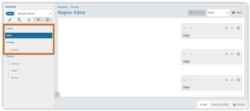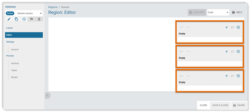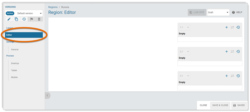What's inside this article:
- Basic information
- Get started
- Save changes
- Manage layout blocks
- Manage widgets
- Add connected Categories
- Publish a Region
Basic information
A Region is a collection of widgets, custom built by a web editor in Pangea CMS. Regions are displayed on content pages. When your website is opened on desktop, a Region is displayed in one column at the side of the page. On mobile, a Region is displayed in one column below the main content.
Regions can improve engagement and retention by promoting other content that might be of interest for your readers.
Where is a Region displayed?
Each Region can be connected to one or more Categories. After a Region is published and connected to a Category, the Region is displayed on content pages where the connected Category is added as the Primary Category (only on content page types that support Regions). Regions are supported on the following content page types:
- Article | Blog | FactCheck | Feature | News | Transcript
To learn more about Categories / Primary Categories, see the following article:
Get started
To start building a new Region:
- Go to Build > Regions.
- Select + Add new.
On the New Region dialog, complete the following required settings:
- Title: The Region title in your local language. This title will be visible only in Pangea CMS.
- English title: The Region title in English. This title will be visible only in Pangea CMS. English titles help Pangea users who do not understand your local language.
Hit Add to confirm. The edit page for the new Region opens. The remaining chapters in this article describe the most important options for building a new Region:
Save changes
The new Region is automatically saved in Pangea CMS with the Draft status. The Region is not visible on the public site.
When a Region has the Draft status, changes to the Region are saved internally in Pangea CMS. Some changes are saved automatically, while other changes need to be saved manually. The following rules apply:
- Changes on the Layout subpage are saved automatically.
- Changes on the Editor subpage are saved automatically.
- Changes on the Settings subpage must be manually saved.
If all changes have been saved (manually or automatically), the action button shows the label Saved and is inactive (not-clickable). This is because the page includes no unsaved changes. When the page includes unsaved changes, you can manually save the changes by hitting the Save button.
Manage layout blocks
By default, a new Region includes 3 layout blocks. Each layout block can contain one widget.
If you want the Region to include more than 3 widgets, you need to add more layout blocks. Follow these steps:
- Select Layout in the left panel.
- Click + Add block in the position where you want to add the new block.
- Select the block under 3 columns.
The block is now added. Go to the Editor subpage to add a widget.
Manage widgets
Widgets are interactive visual elements that showcase your content for website visitors. Pangea CMS offers various widget types that serve different purposes. For an overview of the different widget types, see the following article:
To manage widgets, select Editor in the left panel. Many options are available, for example:
- Add a new widget
- Add a library widget
- Edit a widget
- Move a widget
- Enable / disable a widget
To learn how to manage widgets on the Editor subpage, see the following article:
To learn about the widget settings, see the relevant article below (according to the type of widget):
Content | FactCheck | HTML | Live stream | Manual stream | Multimedia | Podcast | Poll | Subscription | Trends
Add connected Categories
Via General > Categories, you can select one or more Categories.
NOTE: You cannot select a Category that already has a connected Region. Each Category can have only one connected Region.
The Region is displayed on content pages from each connected Category. Find more information in the Basic information chapter of this article.
Publish a Region
To publish a new Region:
- Select Published in the status drop-down menu.
- Hit Publish / Publish & close.
The Region is now published. If it has at least one connected Category, it is visible on the public site.




















